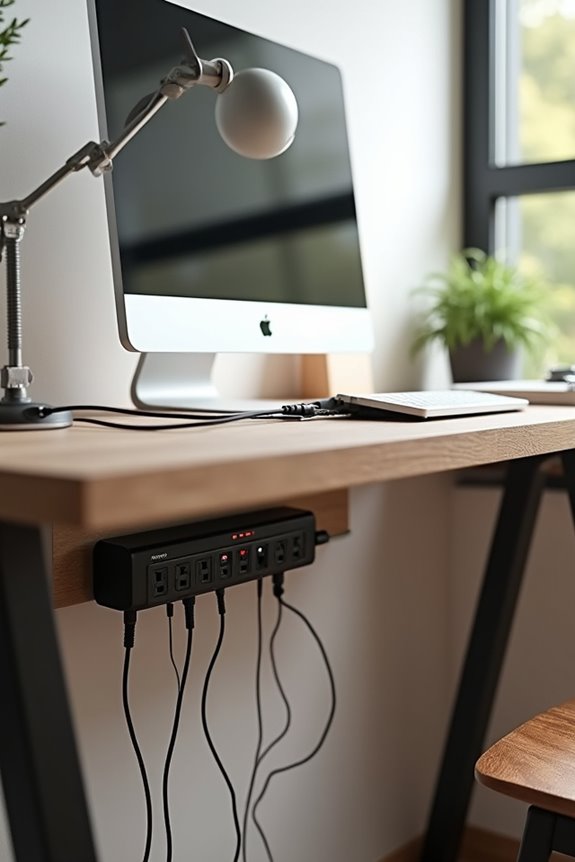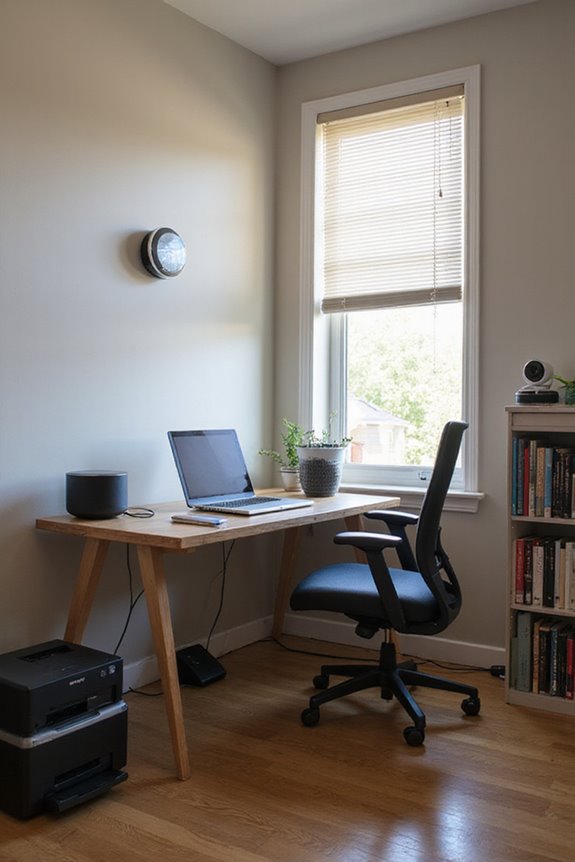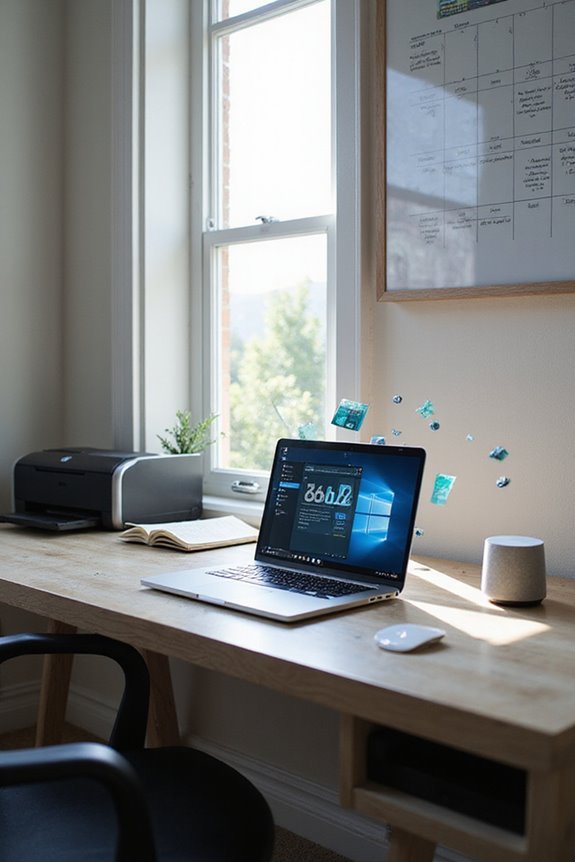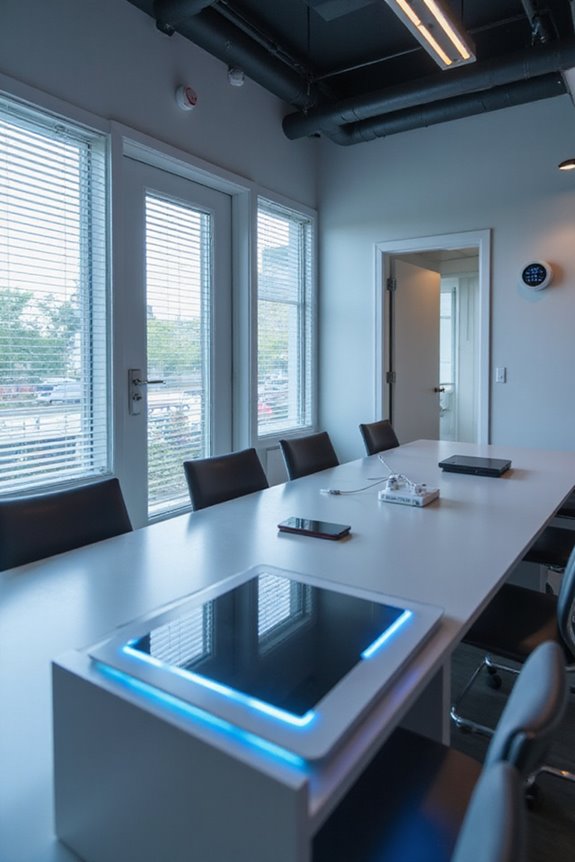For a home office, I recommend looking for a surge protector with at least 600 joules and a clamping voltage between 330–400 volts. Brands like Tripp Lite and Belkin offer reliable options, including models with multiple outlets and USB ports. If you need more extensive protection, consider a whole-house surge protector. Assess your devices’ value and sensitivity to surges for the best fit. Explore more about the variety of surge protectors available to see what suits your needs.
Key Takeaways
- Choose surge protectors with a joule rating of at least 600 for effective protection of your home office devices.
- Consider advanced surge protectors with multiple outlets to accommodate various electronics and peripherals.
- Look for models with clamping voltage below 400 volts to ensure better surge suppression.
- Battery backup options (UPS) provide both surge protection and power during outages, ideal for sensitive equipment.
- Evaluate your budget; quality surge protectors typically range from $15 to $50, offering good value for multiple devices.
Key Features to Look for in Surge Protectors
When choosing a surge protector for your home office, it’s vital to understand the key features that can considerably impact your devices’ safety and performance. First, consider the surge protector types available: power strip surge protectors, network surge protectors, and whole-house surge protectors, each serving different needs. Additionally, check the clamping voltage; a lower clamping voltage, ideally between 330–400 volts, guarantees a quicker response to surges. Look for a surge protector with a joule rating of at least 600 joules, as this indicates better surge absorption capabilities. Finally, verify it has a UL 1449 certification, confirming it meets safety standards. By focusing on these features, you can protect your essential devices effectively.
Top Surge Protector Recommendations
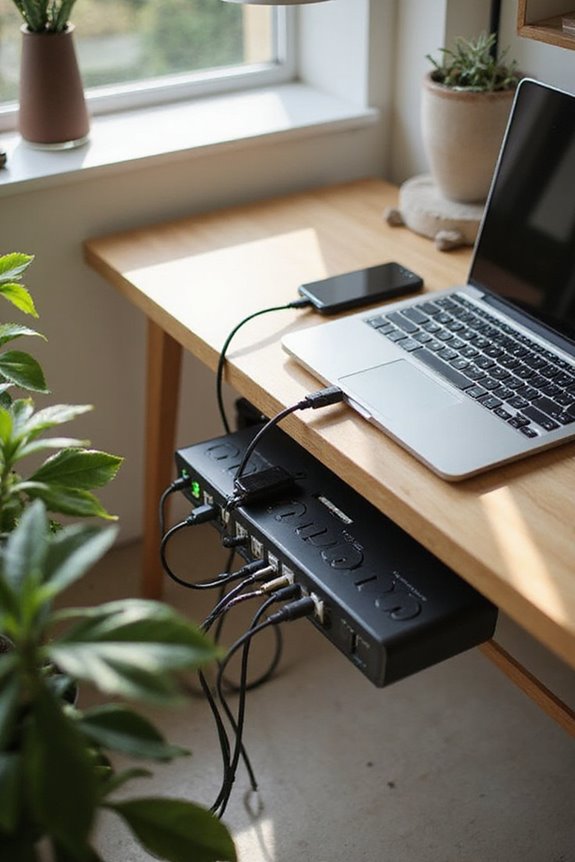
To guarantee your home office is well-protected against power surges, I’ve compiled a list of top surge protector recommendations that cater to various needs and setups.
- Tripp Lite TLP1208TELTV: Great for protecting landlines and cable equipment.
- Belkin Conserve Switch F7C01008q: Ideal for home theater setups with a wireless switch.
- Anker A9192: Perfect for compact spaces with multiple outlets and USB ports.
- APC Surge Protector: Renowned for reliable performance.
- Belkin 12 Outlet Surge Protector: Best for larger setups with a high joule rating.
I’ve found user reviews and detailed surge protector comparisons to be invaluable in selecting the right model for my specific needs, ensuring that my electronics remain safe and functional.
Understanding Joule Ratings and Their Importance
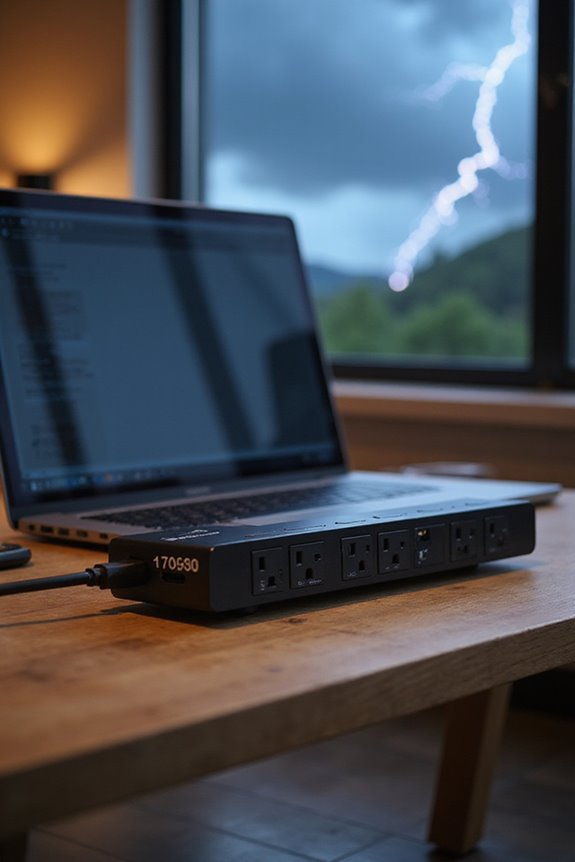
Understanding Joule ratings is vital for anyone looking to protect their home office equipment effectively. Joule ratings measure the energy a surge protector can absorb before it fails, and higher ratings mean better protection against power surges. When making surge protector selection decisions, I recommend considering joule rating comparisons. For instance, 500-1000 joules suffice for small devices, while 2000-3000 joules are better suited for sensitive electronics. It’s important to assess the value and sensitivity of your devices, as well as the frequency of surges in your area. Investing in a surge protector with a higher joule rating can extend its lifespan and guarantee your valuable equipment remains safe from potential damage. Additionally, surge protectors with high joules ratings offer robust protection against electrical surges that can occur during storms.
Types of Surge Protectors for Home Offices
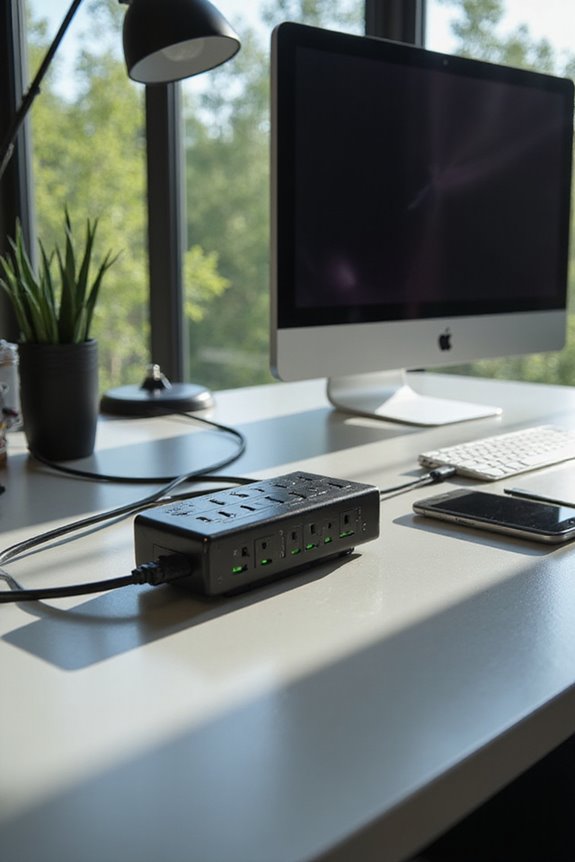
Choosing the right surge protector for your home office can greatly impact the safety and longevity of your equipment.
- Basic Protectors: These budget-friendly options are ideal for small setups, offering lower joule ratings and fewer outlets.
- Advanced Options: For larger offices with multiple devices, these provide higher joule ratings and increased outlet counts.
- Battery Backup: UPS models protect against surges and power outages, ensuring your devices stay operational.
- Whole Home Protection: Installed at the electrical panel, this option safeguards all electronics in your home.
- Specialized Designs: Available in various styles like plug-in, in-line, or rack mount, they cater to specific needs.
When choosing, consider installation methods and warranty considerations for maximum protection.
Energy Absorption Capabilities Explained
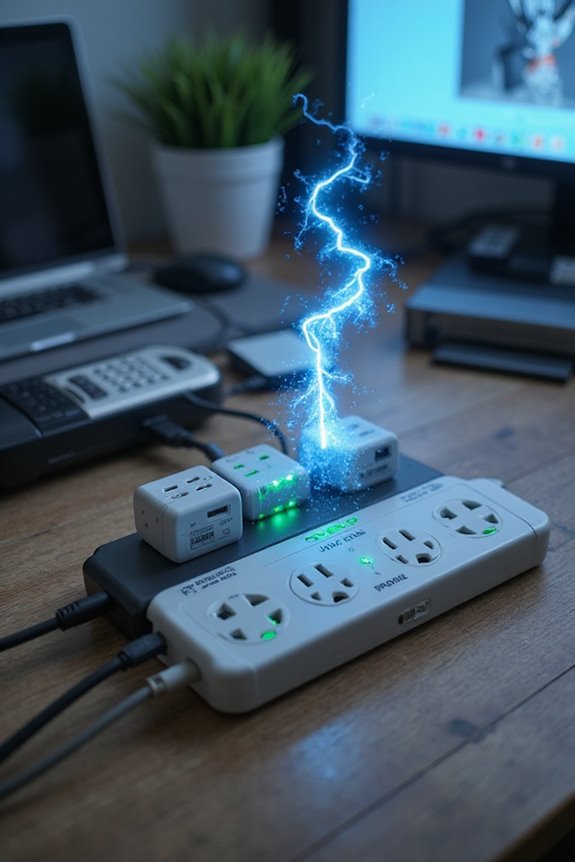
Energy absorption capabilities are a crucial aspect of surge protectors, directly influencing their effectiveness in safeguarding your electronic devices. Fundamentally, energy absorption refers to the surge protector’s ability to absorb and dissipate excess energy from voltage spikes. This is measured by the joule rating, with higher ratings indicating greater protection.
Metal oxide varistors (MOVs) play a significant role in this process, diverting excess voltage to the ground and guaranteeing rapid response times, typically in nanoseconds. However, it’s important to remember that surges can accumulate, which can impact the protector’s lifespan. To provide ideal protection, choose a surge protector with a suitable joule rating and confirm your electrical system is properly grounded for effective energy absorption.
Installation and Maintenance Tips
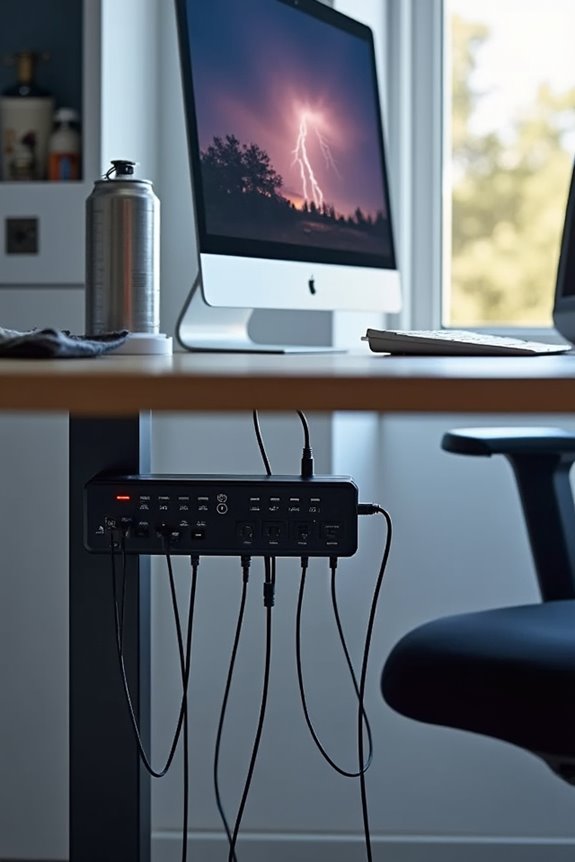
When installing a surge protector, it’s essential to follow a systematic approach to guarantee both safety and effectiveness. First, always shut off the main electrical power to prevent electrical shock. Next, prepare your electrical panel by removing any necessary breakers to accommodate the surge protector.
Installation Best Practices:
- Choose a Type 1 surge protector for maximum protection.
- Confirm compatibility with your panel type.
- If required, drill and secure the surge protector to the panel.
Surge Protector Safety:
- Wear safety gloves and glasses during installation.
- Follow the manufacturer’s instructions closely.
- Regularly inspect the surge protector for signs of wear or malfunction, confirming it’s functioning properly for your home office.
Cost Considerations and Value for Money
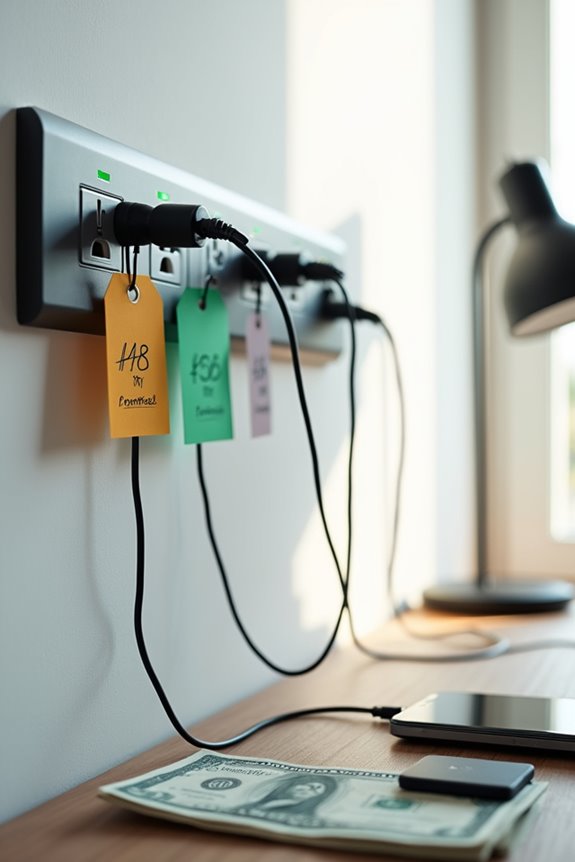
While investing in a surge protector might seem straightforward, understanding the cost implications and potential value for money can greatly impact your decision. Surge protectors typically range from $15 to $50, with higher prices often justified by features like high joule ratings and multiple outlets. For instance, the Belkin surge protector with 12 outlets offers great value, letting you protect multiple devices simultaneously. If you’re on a budget, options like the One Beat 6-Outlet Surge Protector start around $12. Additionally, consider warranty benefits; products with lifetime warranties and high insurance coverage for connected devices enhance overall value. Ultimately, choosing the right surge protector can save you money by safeguarding your electronics against potential damage.
Brand Reputation and Reliability
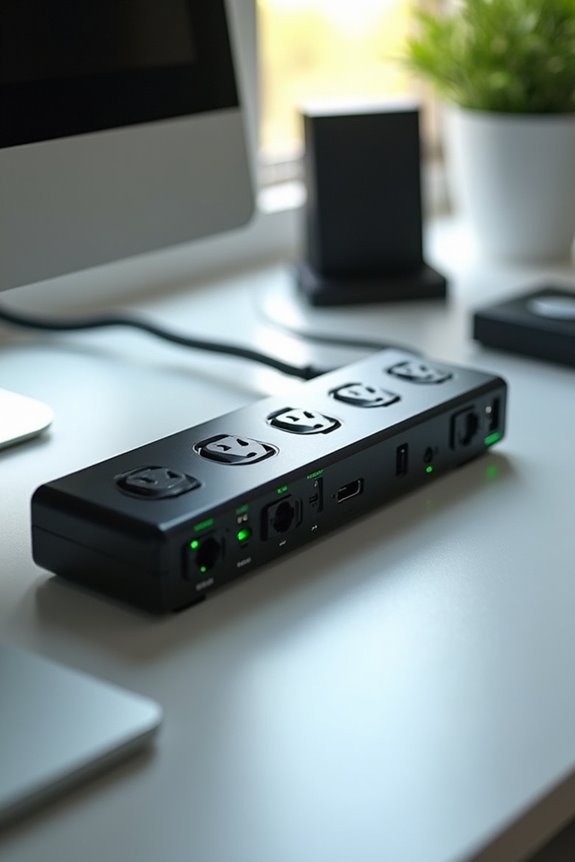
Understanding the brand reputation and reliability of surge protectors is essential for making an informed choice. When I consider brands like Tripp Lite and APC, I notice their strong consumer feedback and brand loyalty, which often stems from their proven performance. Tripp Lite is consistently praised for its reliability, while APC is recognized for robust surge protection systems. However, I’ve seen mixed reviews for Belkin, where some users report quality issues despite its popularity. Anker stands out for its fast-charging capabilities and reliability in accessories. Ultimately, choosing a reputable brand can greatly impact the protection of your home office equipment, ensuring you invest in a surge protector that meets your needs and offers peace of mind.
Frequently Asked Questions
How Often Should I Replace My Surge Protector?
I usually replace my surge protector every two years to guarantee ideal safety. I watch for replacement indicators like the “Protection Working” LED going out, which signals it’s time to invest in a new one.
Can Surge Protectors Protect Against Lightning Strikes?
Surge protectors aren’t enough for lightning protection; their surge ratings can’t handle direct strikes. I’ve learned that using dedicated lightning arresters is essential to safeguard my electronics and avoid costly damage from lightning-induced surges.
Are Surge Protectors Safe for Sensitive Electronics?
Did you know 60% of electronics failures stem from power surges? I always prioritize electronic safety with surge protection, ensuring my devices stay safe from spikes that could jeopardize their performance and longevity.
Do Surge Protectors Consume Electricity When Not in Use?
Surge protectors can contribute to idle power consumption, but their efficiency varies. When not in use, some models reduce energy use markedly, especially if they have switches or smart features. Always check the specs to minimize waste.
Can I Use a Surge Protector With a Power Strip?
I wouldn’t recommend using a surge protector with a power strip, as their compatibility can cause issues. Power strip features are primarily for additional outlets, not surge protection, which could compromise your devices’ safety.

